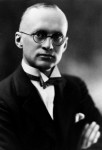![]()
“Our mammalian ancestors 100 million years ago never got scurvy, for example, because they could make their own vitamin C.
Many vertebrates can make vitamin C, and use an identical set of genes to do so. “We should be able to make it, too, since we have all the genes,” said Rebecca Stevens of the French National Institute for Agricultural Research.
Unlike a frog or a kangaroo, however, we have crippling mutations in one of those genes, known as GULO. Unable to make the GULO protein, we cannot produce vitamin C.
“It’s not just us — it goes back a long time,” said Guy Drouin, a molecular evolutionary biologist at the University of Ottawa. He and other researchers have found that apes and monkeys, our closest primate relatives, have disabled GULO genes, with many of the same mutations. Dr. Drouin has concluded that the common ancestor we share with those other primates lost the ability to make vitamin C around 60 million years ago….
 Now that scientists can scan genomes of thousands of species, they’re discovering many more cases in which vitamin genes have either decayed or disappeared altogether. Sergio Sanudo-Wilhelmy of the University of Southern California and his colleagues recently surveyed the genomes of 400 of the most abundant species of bacteria in the oceans. As they report in a paper to be published in the Annual Review of Marine Science, 24 percent of the bacteria lack genes to make B1, and 63 percent can’t make B12.
Now that scientists can scan genomes of thousands of species, they’re discovering many more cases in which vitamin genes have either decayed or disappeared altogether. Sergio Sanudo-Wilhelmy of the University of Southern California and his colleagues recently surveyed the genomes of 400 of the most abundant species of bacteria in the oceans. As they report in a paper to be published in the Annual Review of Marine Science, 24 percent of the bacteria lack genes to make B1, and 63 percent can’t make B12.
from: “Vitamins’ Old, Old Edge” by Carl Zimmer in the New York Times Dec 10, 2013



